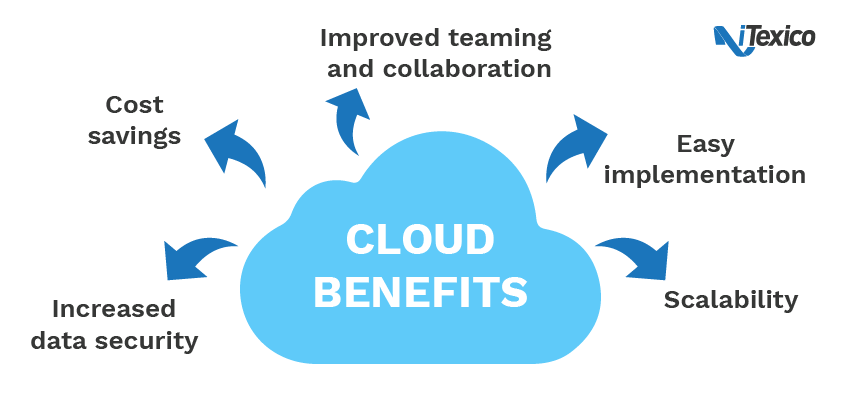The Benefits of Leveraging Cloud Migration Services
You’re always looking for an edge over your competition. Overcoming those obstacles may not be at the forefront of your decision-making, but every effort you make to improve your company is because the business world is inherently competitive. Your company needs to be attractive to new consumers, cognizant of what they want, how they feel, and how you can help. You can’t afford to let your organization get stale.
Progressive advancement means searching out new ways to improve your customers’ experience with whatever services you may provide. The cloud is only one of the latest developments that has had a massive impact on how society interacts with their world. Simply put, it’s become an integral part of how customers run their lives, and it's important for seeing your business grow.
That being said, you should have some idea of what you’re getting into and what cloud migration can bring to the table. Knowledge is half the battle, and the other half is jumping on the bandwagon sooner rather than later to boost your organization’s success.
What Are Cloud Migration Services?
To give you a clear idea, cloud migration is the process of moving data and applications from computers or hardware to the cloud, which is comprised of software and services that run on the Internet. The cloud can be accessed from any device from anywhere, so long as you have an Internet connection.
Before the advent of the cloud, the data and applications that’d be relevant to your work could only be reached through on-premises servers. If you worked for a software company, you’d be required to come into work and sit behind a company-owned computer to be able to access your work materials. The cloud does away with that necessity.
By allowing companies to access vital information from anywhere, without relying on local servers, a whole new world opened up. The cloud isn’t a golden ticket, as there are some benefits that local servers hold over them, but the positives generally greatly outweigh the negatives.
Whether you realize it or not, you’re already making ample use of the cloud yourself. With the amount of companies that have successfully migrated to the cloud, you’ve picked up something in your day-to-day activities that has directly leveraged cloud computing services to bring what you need right into your hands. Netflix, Facebook, Amazon, Google, Adobe, we can go on for thousands.
But making the transfer isn’t exactly simple. There’s effort, time, planning, and patience that goes into a successful cloud migration. However, it’s only as hard as you make it to be on your own. Cloud migration services are available from a variety of companies, just like iTexico, that strive to help make the transition as painless and easy as possible.
iTexico provides the services necessary to completely make the transition to the cloud. Dividing employees into dedicated teams, determining what can and shouldn’t be taken to the cloud, managing automation, and more responsibilities can be handled with the expert care they deserve. It’s complicated, we know. That’s why we’re here to help.
What Are the Benefits of Leveraging Cloud Migration?
There are plenty of issues that come concurrently with reliance on hardware. Common problems that tend to arise include a higher risk of business failure, greater workloads, lower productivity, greater spending, slower commerce, and dependence on using a local server network. Restrictive use of hardware as a data storage platform generally makes business harder, slower, and more challenging for the majority of businesses.
When full cloud migration is complete, it’s been found that cloud solutions decrease small business workload by at least 42%. Frankly, that’s a significant percentage that’s lifted off your employees shoulders. The measurable impacts that result from being able to focus more attention on your company’s core competencies manufactures a more productive environment.
But now you want to know a little bit more about the big question here: what are the benefits of leveraging cloud migration? What areas will your company automatically improve on just from incorporating this technology into your daily business?

Cost Savings
When you’re using on-premises data centers, the costs are going to add up. Given any reasonable time, you’re going to need to pour money in to keep your company working. This can range for any conceivable expenditure that you’ll inevitably end up pulling your wallet out for: hardware, technicians, IT support, storage, and plenty of other issues that you may simply be blindsided by.
Risking a sucker punch is no way to run a business. Cloud service providers come equipped with packages to provide you with a cost-effective experience to safely run your company without risking undue costs. It’s like insurance, in a way. These packages are based on features, storage, number of users, memory space, and so on to be able to fit your particular situation.
These packages leave the option open for you to choose one that fits your budget and your needs. Every enterprise is different, and therefore need to compensate for their unique business strategies. The result? A cost-effective data center that capitalizes efficiency while keeping spending reasonable.
Scalability
Traditional data storage systems drastically fall short of the scalability you need to effectively keep up with modern growth. Think about it: you can only have as much storage as you have hardware, a technology with finite space, both physically and digitally. There’s nothing Agile about hardware, no compartmentable method to adjust accordingly to the needs of your growth.
Compare this dated method of data storage to the cloud. The ease at which you can scale to conform to your company outpaces traditional storage systems by a country mile. There’s no constraint of physical space, no rigidity of technology to limit your capabilities. As long as you have the budget, you’re capable of scaling the cloud storage system per necessity.
With payment, you can have additional features or storage space at any time via upgrading your cloud service provider. With traditional systems you’d be forced to purchase the requisite technology and install it, leading to a drawn out, clunky installment that slows productivity. Upgrading through the cloud takes both minimum effort and time on your part.
The overall necessity of your effectiveness depends on the scalability of the data storage system. Cloud services allow you to scale up or scale down your storage or features as needed, a practice not provided with traditional systems. If you had storage or features you no longer needed historically, it was more effort than it was worth to clear them out, leading to assets gathering dust and space.
Improved Teaming and Collaboration
One of the cloud’s greatest assets is its mobility, allowing employees the flexibility to work from any location with a strong internet connection. Theoretically, this could mean employees could work from coffee shops, across state lines, overseas, or from the comfort of their own homes. This actually helps businesses avoid additional costs by implementing home office hours/days, cutting off long commute times and implementing a therapeutic yet professional atmosphere.
The ever-present capability to also permits boosts communication quality within teams. Improving collaboration by allowing the workforce to easily share information and collaborate wherever each team member is a feat that’s only been recently achieved with the advent of the cloud. So long as your team is connected to the internet, they have access to data from multiple devices and are able to update documents in real-time.
Vacations no longer need to be the wedge in a project’s completion. Of course, you’re not expecting employees to take their work on vacation with them, but info they may be privy to can be readily shared with their team, smoothing over possible wrinkles. Plus, being able to keep in contact, just in case, from anywhere ensures that projects can move forward through the cloud through any tablet, laptop, or smartphone.
You may also want to give some thought toward collaboration with external providers, giving them access to your online documents. Traditional methods to stay updated were very direct, person-to-person, and largely needed massive collaborative efforts just to stay on the same page. With an external provider, everybody involved can simply login and see the information at their own convenience, making constant tracking what information each member of a team possesses a moot issue.
Increased Data Security
Traditional data centers and cloud centers both admit to receiving a similar number of attacks, 44% and 53% respectively. However, on-premises environments are at a much higher risk than cloud-based attempts, being more vulnerable to successful attacks. Where the figures stand, traditional data storage centers are simply not as secure as their cloud counterparts.
But why is it that on-premises environments are so much more vulnerable to attacks? Simply put, hardware is prone to security breaches by being stolen. Traditional IT is tangible, whereas the cloud can’t be picked up and stuffed in a coat pocket.
The difference between hardware and the cloud is like comparing a cage to a safe. A cage represents a physical location where something can be kept, but retrieval is generally straightforward: break the lock, take what’s in side, get out. A safe isn’t so easy, is it? Data is most secure when you need a code to get to the goods.
Location isn’t what makes data safe, access is. By restricting access your system, you’re functionally doing a better job at resisting attacks than hardware ever could. The cloud offers the type of strong security you’re looking for with data encryption and strong password requirements that effectively controls who has access to your data.
Easy Implementation
The cloud is a system that doesn’t need or want your company’s oversight. It’s a platform that’s cared for by another company, meaning your own doesn’t need to bother with any of the maintenance traditionally needed to keep your data storage system running smoothly. With the cloud’s regular software and security updates, your business strategy can shift reinvest that time into other productive means.
Migrating to the cloud, simply put, is easy. It does take some work, certainly, but by comparison to traditional standards it’s a walk in the park. So long as you take the time to properly manage, plan, and execute the migration with poise, the entire transition should proceed without a bump in the road.
The migration shouldn’t be tackled alone, however. The migration may be easy, but the process as a whole becomes a whole lot smoother and secure when you have an experienced hand guide you through it. That’s why iTexico offers our expertise in helping you make the move. iTexico’s Cloud Innovation Center of Excellence can help you make the transition seamlessly from a data center to the cloud, ensuring an efficient, painless migration.
Wrapping Up
Traditional data centers may have been an innovation at one time, but as the onward march of time, technology, and business dictates, the landscape has changed. There is still a place for it, but the cloud has proven to be superior for the majority of businesses. Whether it be in terms of cost savings, scalability, teams and collaboration, security, or implementation, then migrating to the cloud tends to be the smart choice.
If you’re interested in migrating to the cloud, then we’re more than happy to help you get started. To get an idea for what to expect, iTexico has a Free Cloud Migration Assessment Report prepared for your convenience. Take the time to give it some consideration, and iTexico will provide the means to bring your company the success it deserves.
Hand-Picked Related Reads For You

Cloud Migration Strategy & Best Practices
READ MORE

10 Cloud Computing Success Stories
READ MORE

What is Cloud Adoption?
READ MORE





Post Your Comment Here